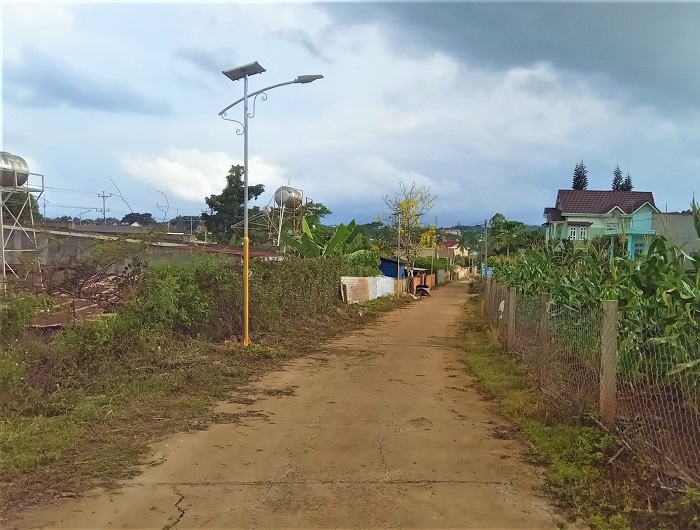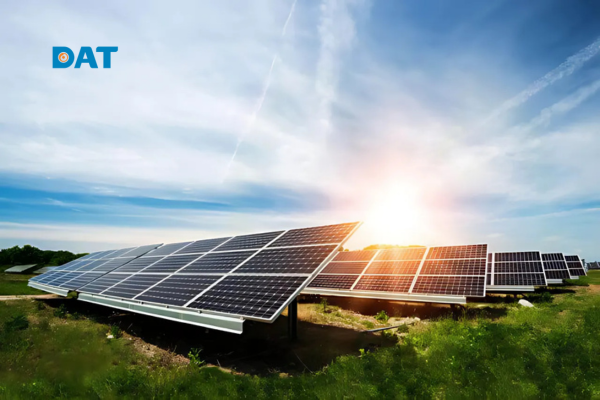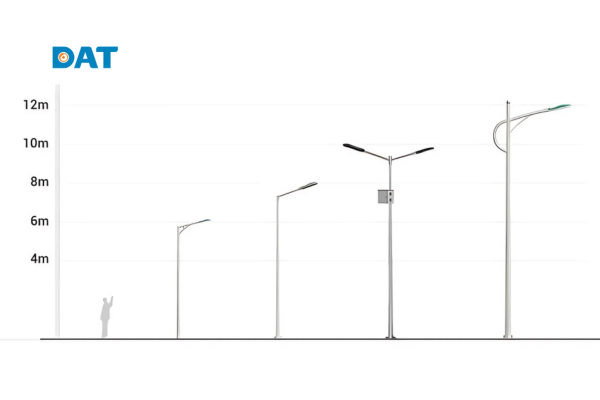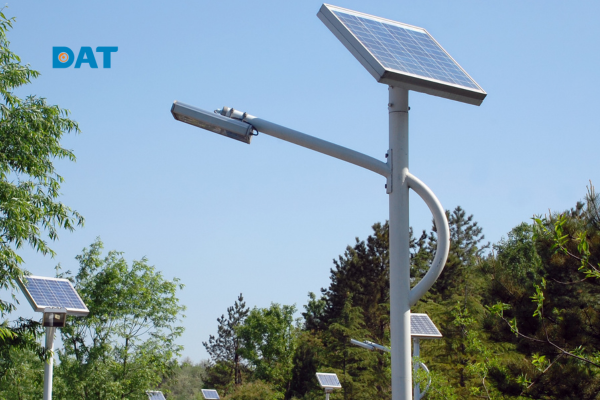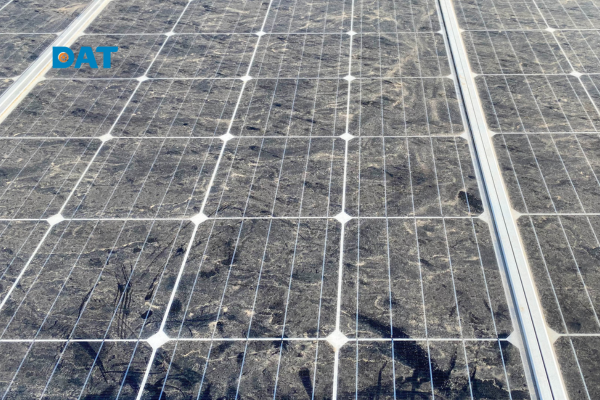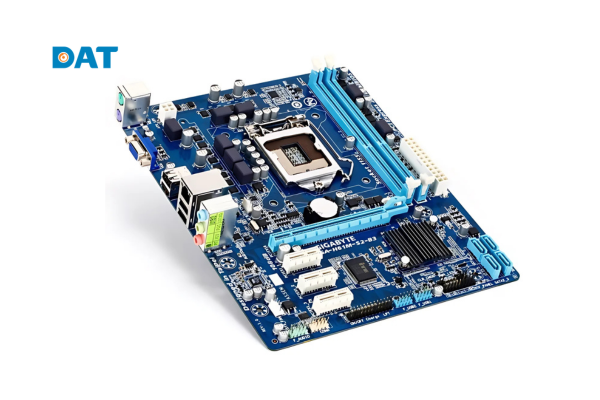Đèn năng lượng mặt trời cho giao thông chính hãng – giá tốt
Đèn giao thông năng lượng mặt trời là thiết bị chiếu sáng thông minh, hoạt động hoàn toàn bằng năng lượng mặt trời, được ứng dụng rộng rãi để hướng dẫn, cảnh báo và quản lý giao thông tại các khu vực nông thôn, đô thị và các điểm giao thông trọng yếu. Với sứ mệnh “Thắp sáng mọi con đường bằng năng lượng sạch”, DAT Group không ngừng nghiên cứu và tư vấn các giải pháp chiếu sáng giao thông hiệu quả, an toàn và thân thiện với môi trường, góp phần nâng cao chất lượng hạ tầng giao thông và bảo vệ môi trường tại Việt Nam.
1. Đèn giao thông năng lượng mặt trời là gì?
Đèn giao thông năng lượng mặt trời là thiết bị chiếu sáng hiện đại, hoạt động hoàn toàn bằng nguồn năng lượng mặt trời, được thiết kế để hướng dẫn, cảnh báo và quản lý giao thông tại các khu vực không có điện lưới hoặc điện không ổn định. Đây là giải pháp đáng tin cậy giúp tăng cường an toàn giao thông, đặc biệt tại các vị trí nguy hiểm, khu vực công trình xây dựng, hoặc các điểm giao thông phức tạp, nơi cần đảm bảo ánh sáng và cảnh báo rõ ràng vào ban đêm hoặc trong điều kiện thời tiết xấu.
Đèn giao thông năng lượng mặt trời còn được gọi là đèn cảnh báo giao thông, đóng vai trò quan trọng trong việc giúp người tham gia giao thông nhận diện các khu vực có nguy cơ, tăng cường sự tập trung và giảm tốc độ, từ đó giảm thiểu nguy cơ tai nạn. Những chiếc đèn này thường được lắp đặt tại các điểm quan trọng như ngã tư, đoạn đường quanh điểm quay đầu, nơi dễ xảy ra va chạm, gần trường học, bệnh viện, chợ, hoặc các khu vực có mật độ người và phương tiện lưu thông cao. Ngoài ra, chúng cũng được triển khai tại các khu vực đang thi công, giúp cảnh báo và phân luồng giao thông hiệu quả, đảm bảo an toàn cho người dân và phương tiện di chuyển.
Việc ứng dụng đèn giao thông năng lượng mặt trời không chỉ giúp tiết kiệm chi phí vận hành, bảo vệ môi trường mà còn góp phần nâng cao hiệu quả quản lý giao thông tại cả khu vực đô thị và nông thôn, mang lại ánh sáng an toàn và ổn định cho cộng đồng.
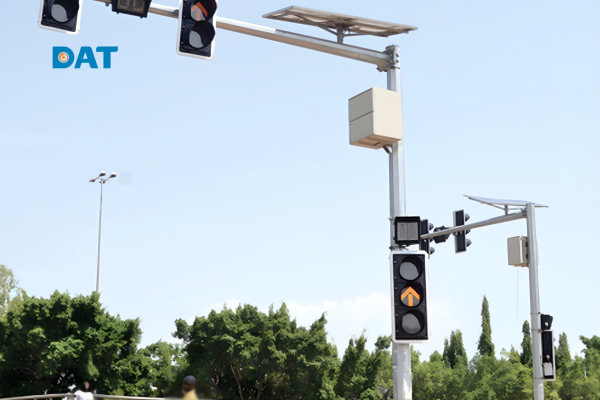
2. Cấu tạo và đặc điểm kỹ thuật đèn giao thông năng lượng mặt trời
Đèn giao thông năng lượng mặt trời được thiết kế với nhiều bộ phận quan trọng, đảm bảo hoạt động ổn định và hiệu quả trong mọi điều kiện môi trường:
-
Cột đèn: Được chế tạo từ các vật liệu bền bỉ như thép, nhôm hoặc hợp kim nhôm, cột đèn đảm bảo độ cứng cáp, chịu được va đập và thời tiết khắc nghiệt. Thiết kế cột đèn còn giúp bảo vệ các linh kiện bên trong và tạo sự ổn định cho toàn bộ hệ thống.
-
Tấm pin mặt trời: Là bộ phận thu năng lượng chính, tấm pin được làm từ vật liệu bán dẫn như silicon, có khả năng chuyển đổi ánh sáng mặt trời thành điện năng hiệu quả. Tấm pin chất lượng cao có tuổi thọ lâu dài, tối ưu hóa hiệu suất thu năng lượng và được lắp đặt ở vị trí phù hợp để hấp thụ ánh sáng tốt nhất.
-
Pin sạc lithium: Đóng vai trò lưu trữ điện năng, pin lithium có hiệu suất cao, tuổi thọ lên đến 10 năm, sạc nhanh và xả ổn định, giúp đèn hoạt động liên tục cả khi không có ánh sáng mặt trời.
-
Bóng đèn LED: Sử dụng công nghệ LED tiên tiến, đèn có độ sáng mạnh, tiết kiệm điện, tuổi thọ cao và nhiều màu sắc tùy theo mục đích sử dụng. Đèn LED cung cấp ánh sáng rõ ràng, hỗ trợ cảnh báo và điều tiết giao thông hiệu quả.
-
Tủ điều khiển: Là bộ phận trung tâm, tủ điều khiển quản lý toàn bộ hoạt động của đèn, tự động điều chỉnh độ sáng, giám sát và báo lỗi từ xa. Hệ thống điều khiển thông minh giúp đèn hoạt động hiệu quả, tiết kiệm năng lượng và dễ dàng quản lý.
Toàn bộ cấu tạo được thiết kế để chống bụi, chống thấm nước, đảm bảo độ bền và an toàn trong môi trường giao thông khắc nghiệt, đồng thời dễ dàng lắp đặt và di chuyển theo nhu cầu thực tế.
3. Nguyên lý hoạt động đèn giao thông năng lượng mặt trời

Hệ thống đèn giao thông năng lượng mặt trời hoạt động bằng cách tận dụng ánh sáng mặt trời để sản xuất điện năng, cung cấp nguồn cho toàn bộ hệ thống. Các thành phần chính bao gồm:
-
Tấm pin mặt trời: Được làm từ vật liệu bán dẫn như silicon, tấm pin chứa các tế bào quang điện. Khi ánh sáng mặt trời chiếu vào, các tế bào này chuyển đổi năng lượng ánh sáng thành dòng điện một chiều, là nguồn năng lượng cốt lõi cho hệ thống.
-
Bộ điều khiển: Quản lý quá trình sạc và xả pin, điều chỉnh việc cung cấp điện cho đèn LED theo điều kiện ánh sáng môi trường. Nhờ bộ điều khiển thông minh, đèn hoạt động hiệu quả và tiết kiệm năng lượng tối đa.
-
Pin lưu trữ: Thu thập và lưu trữ điện năng từ tấm pin mặt trời, giúp đèn hoạt động ổn định cả khi không có ánh sáng mặt trời, như ban đêm hoặc trong điều kiện thời tiết mây mù.
-
Đèn LED: Sử dụng công nghệ LED tiên tiến để phát sáng, cung cấp ánh sáng mạnh, tiết kiệm điện và có tuổi thọ cao, phù hợp với môi trường giao thông khắc nghiệt.
Toàn bộ hệ thống hoạt động tự động, không phụ thuộc vào lưới điện, giúp đèn giao thông năng lượng mặt trời luôn sẵn sàng hoạt động, đảm bảo an toàn và hiệu quả cho người tham gia giao thông.
4. Các loại đèn giao thông năng lượng mặt trời thông dụng hiện nay
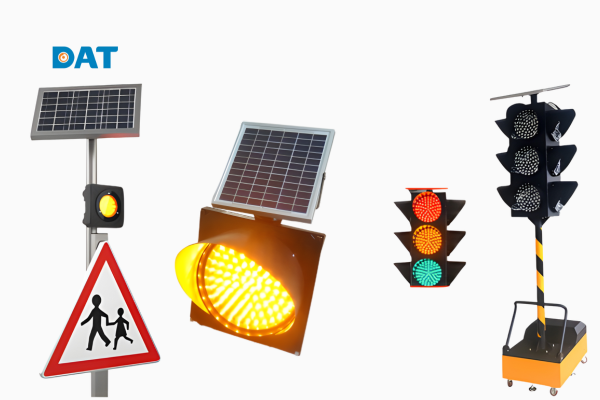
Với sự phát triển không ngừng của công nghệ năng lượng mặt trời, các loại đèn giao thông năng lượng mặt trời ngày càng đa dạng và linh hoạt, đáp ứng nhiều nhu cầu ứng dụng khác nhau trong thực tế. Dưới đây là một số mẫu đèn giao thông năng lượng mặt trời phổ biến và được ưa chuộng hiện nay:
-
Đèn chớp vàng năng lượng mặt trời: Loại đèn này được sử dụng chủ yếu để cảnh báo, giúp người tham gia giao thông nhận diện các khu vực tiềm ẩn nguy hiểm. Có nhiều tùy chọn thiết kế, từ bộ 1 đèn, 2 đèn đến các bộ kết hợp với bảng LED, phù hợp với cả tuyến giao thông nhỏ và các điểm giao thông trọng yếu.
-
Đèn cảnh báo di động: Được trang bị bánh xe, đèn cảnh báo di động năng lượng mặt trời có thể dễ dàng di chuyển và lắp đặt tại các vị trí tạm thời như sân bay, bến xe, cảng, hoặc khu vực đang thi công. Đèn hoạt động hoàn toàn bằng năng lượng mặt trời, giúp tiết kiệm chi phí và tăng tính linh hoạt.
-
Đèn cảnh báo nguy hiểm: Loại đèn này được sử dụng để cảnh báo về các vật cản, khu vực thi công, hoặc phân chia làn đường. Đèn cảnh báo nguy hiểm năng lượng mặt trời giúp tăng cường an toàn giao thông, đặc biệt tại các điểm dễ xảy ra tai nạn.
-
Đèn chỉ dẫn âm sàn: Đèn chỉ dẫn giao thông năng lượng mặt trời âm sàn được lắp đặt dưới mặt đường, tự động sáng vào ban đêm và tắt vào ban ngày. Đèn có bề mặt phản quang, giúp phân chia làn đường rõ ràng và tăng khả năng nhận diện cho người tham gia giao thông, đặc biệt tại các đoạn đường có thiết kế đặc biệt như đoạn đường xương cá.
-
Đèn tín hiệu giao thông 3 màu: Loại đèn này gồm 3 màu đỏ – vàng – xanh, dùng để điều khiển giao thông tại các điểm giao, ngã ba, ngã tư, giúp giảm thiểu tình trạng ùn tắc và đảm bảo an toàn cho người tham gia giao thông.
-
Đèn tín hiệu dành cho người đi bộ và xe đạp: Đèn tín hiệu dành riêng cho người đi bộ và người đi xe đạp, thường có biểu tượng hình người hoặc xe đạp, giúp điều tiết giao thông tại các khu vực dành riêng cho các phương tiện này.
Các loại đèn giao thông năng lượng mặt trời không chỉ đa dạng về mẫu mã, mà còn được thiết kế để dễ dàng lắp đặt, vận hành ổn định và thân thiện với môi trường, phù hợp với nhiều điều kiện giao thông tại Việt Nam.
5. Lợi ích khi sử dụng đèn giao thông năng lượng mặt trời
Hệ thống đèn giao thông năng lượng mặt trời mang lại nhiều lợi ích vượt trội so với các loại đèn tín hiệu truyền thống sử dụng điện lưới:
-
Tiện lợi trong thi công và lắp đặt: Không cần đào đường, kéo dây điện phức tạp, giúp tiết kiệm thời gian và chi phí thi công, phù hợp với cả khu vực đô thị và nông thôn.
-
Sử dụng nguồn năng lượng tự nhiên: Tận dụng ánh sáng mặt trời – nguồn năng lượng tái tạo, giúp giảm chi phí điện năng, bảo vệ môi trường và giảm phát thải khí thải carbon.
-
Độc lập với mạng điện: Hệ thống hoạt động ổn định, không bị gián đoạn kể cả khi cúp điện hoặc mất điện lưới, đảm bảo an toàn giao thông liên tục.
-
Tự động điều chỉnh độ sáng: Trang bị cảm biến ánh sáng, đèn tự động bật/tắt và điều chỉnh độ sáng phù hợp với điều kiện môi trường, giúp tiết kiệm năng lượng và nâng cao hiệu quả chiếu sáng.
-
Chống bụi, chống thấm nước: Thiết kế bền bỉ, chịu được điều kiện thời tiết khắc nghiệt, tăng tuổi thọ và độ tin cậy của hệ thống.
-
Dễ dàng di chuyển và tái sử dụng: Có thể lắp đặt hoặc di chuyển linh hoạt theo nhu cầu, phù hợp với các khu vực tạm thời hoặc thường xuyên thay đổi vị trí.
6. Ứng dụng đa dạng của đèn giao thông năng lượng mặt trời
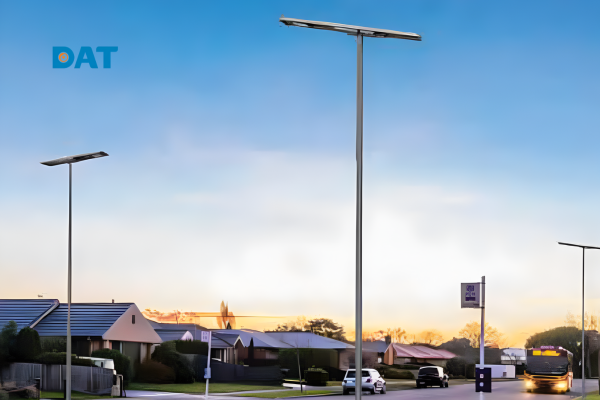
Đèn giao thông năng lượng mặt trời có nhiều ứng dụng quan trọng, góp phần nâng cao hiệu quả và an toàn cho hệ thống giao thông tại cả khu vực đô thị và nông thôn:
-
Đèn tín hiệu giao thông: Được lắp đặt tại các giao lộ, ngã tư, cao tốc và các tuyến đường có lưu lượng giao thông cao, giúp điều tiết và điều hướng giao thông hiệu quả. Đèn tín hiệu giao thông năng lượng mặt trời đảm bảo ánh sáng rõ ràng, giúp người lái xe và người đi bộ nhận diện tín hiệu dễ dàng, duy trì trật tự và an toàn giao thông.
-
Đèn hỗ trợ giao thông: Thường được đặt tại các vị trí như cổng làng, bến xe, cảng phà, điểm giao cắt, nhằm tăng cường tín hiệu giao thông truyền thống, hỗ trợ điều tiết giao thông tại các khu vực nông thôn và thị trấn.
-
Đèn cảnh báo: Dùng để cảnh báo các tình huống nguy hiểm như công trường đang thi công, hạn chế tốc độ, đường trơn trượt hoặc các khu vực có vật cản. Đèn cảnh báo giúp tăng sự chú ý của người tham gia giao thông, giảm nguy cơ tai nạn.
-
Đèn giao thông tạm thời: Phù hợp cho các công trình xây dựng hoặc sửa chữa đường, có thể di chuyển và lắp đặt linh hoạt tại các vị trí tạm thời để điều tiết luồng giao thông, giảm thiểu ảnh hưởng đến việc di chuyển của người dân và phương tiện.
-
Đèn chiếu sáng đường: Ngoài chức năng tín hiệu, đèn giao thông năng lượng mặt trời còn được sử dụng để chiếu sáng các điểm giao cắt, vòng xoay và các đoạn đường thiếu ánh sáng, giúp tăng khả năng nhận diện và đảm bảo an toàn cho người đi bộ, người lái xe vào ban đêm.
Việc ứng dụng đèn giao thông năng lượng mặt trời không chỉ giúp nâng cao hiệu quả quản lý giao thông mà còn góp phần xây dựng môi trường sống bền vững, tiết kiệm năng lượng và bảo vệ môi trường.
Đèn giao thông năng lượng mặt trời đang trở thành giải pháp chiếu sáng thông minh, an toàn và thân thiện với môi trường, góp phần nâng cao hiệu quả quản lý giao thông tại cả khu vực đô thị và nông thôn. Với sứ mệnh “Thắp sáng mọi con đường bằng năng lượng sạch”, DAT Group luôn tiên phong trong việc nghiên cứu, tư vấn và triển khai các giải pháp chiếu sáng giao thông hiện đại, giúp bảo vệ môi trường và nâng cao chất lượng hạ tầng giao thông tại Việt Nam. Dù không cung cấp đèn tín hiệu giao thông năng lượng mặt trời, DAT Group cam kết đồng hành cùng khách hàng trong việc lựa chọn và thiết kế hệ thống đèn chiếu sáng đường năng lượng mặt trời chất lượng cao, đáp ứng mọi nhu cầu chiếu sáng và an toàn giao thông. Liên hệ DAT Group qua hotline 1800 6567 để được tư vấn và hỗ trợ 24/7, cùng xây dựng một tương lai giao thông xanh và bền vững.

